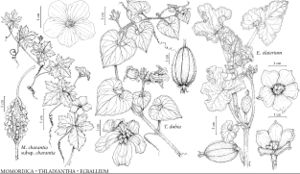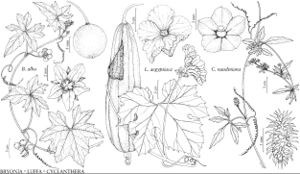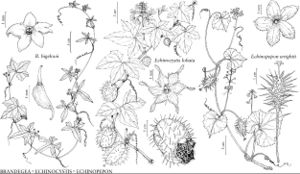Plants usually vines, sometimes shrublike in Cucurbita, or perennial [annual] herbs (Melothria), usually monoecious or dioecious, rarely andromonoecious (Cucumis). Stems prostrate, procumbent, sprawling, trailing, or climbing; tendrils usually present, unbranched or branched. Leaves simple (also compound in Cyclanthera, Momordica), alternate, estipulate, petiolate (sessile or subsessile in Sicyos); blade unlobed or palmately, pedately, or pinnately lobed. Inflorescences paniculate, racemose, umbellate to subumbellate, fasciculate, corymbose, or solitary flowers. Flowers unisexual [bisexual]; sepals (4–)5(–6), sometimes vestigial (Cyclanthera), connate, calyx rotate, campanulate, saucer-shaped, or tubular, adnate to corolla, producing hypanthium; petals 5(–6), distinct or connate, imbricate or induplicate-valvate, usually yellow, orange, or white, sometimes green, margins entire, rarely fimbriate, corolla rotate, cupulate, campanulate, salverform, or funnelform; stamens (2–)3–5, with 4 mostly connate in pairs, appearing as only (1–)3 stamens; anthers connate or distinct, pepos, rarely capsules, elongate to globose, exocarp usually hard, sometimes fleshy and berrylike, glabrous or hairy, smooth or bristly, echinate, aculeate, muricate, tuberculate, or furrowed, indehiscent or dehiscent. Seeds mostly compressed, sometimes winged, arillate in Coccinia, Ibervillea, Momordica, and Tumamoca, exalbuminous; embryos straight.
Distribution
Nearly worldwide, mostly tropical.
Discussion
Genera ca. 120, species ca. 825 (23 genera, 56 species in the flora).
Sechium edule (Jacquin) Swartz (chayote) has been attributed to Louisiana in the PLANTS database on the basis of a putative record in R. D. Thomas and C. M. Allen (1993–1998); there appears to be no such record therein. The only specimen from Louisiana in the NLU herbarium was collected from a cultivated plant in Ouachita Parish. Sechium edule is native to Central America and is grown worldwide as a food crop.
Cucurbitaceae, together with Begoniaceae and other families, is currently placed in Cucurbitales (P. F. Stevens, www.mobot.org/MOBOT/research/APweb), in the same clade as Fabales and Rosales.
The familial classification of Cucurbitaceae by C. Jeffrey (1980b, 1990, 2005) is widely used. Recent phylogenetic studies partly support the groupings outlined by Jeffrey but expected from the classification by Jeffrey’s classification (A. Kocyan et al. 2007; H. Schaefer et al. 2008); the studies suggest that tribes recognized by Jeffrey are largely monophyletic and Initial classifications by C. Jeffrey (1980b, 1990) emphasized fusion of stigmas and tendril morphology; his latest revision (2005) incorporated information from studies of seed coat anatomy by D. Singh and A. S. R. Dathan (1998). In Cucurbitoideae Kosteletzky, the main sclerenchymatous layer of the seed coat is conspicuous and distinct; in Nhandiroboideae Kosteletzky, it is inconspicuous and not clearly distinct from adjacent sclerified hypodermal layers.
The largest genera in the family are Trichosanthes (ca. 100 species), Momordica (ca. 80 species), Zehneria (ca. 60 species), Cucumis (ca. 55 species), Sicyos (ca. 50 species), Cayaponia (45–75 species), and Gurania (ca. 40 species). About 40 of the genera are monospecific.
Cucurbitaceae generally is easy to recognize: the fruit is usually a pepo (a hard-shelled berry). Fruits are produced in a wide array of shapes and sizes, especially as the result of millennia of selection. With intense watering, custom fertilization, and selection for size increase, squashes have been grown to 900 pounds; pumpkins can reach 1800 pounds.
Cucurbitaceae were important in early agriculture in the Americas as one of the three main staple food crops––squash, corn, and beans. Squashes are all native to the New World and provide edible flesh and seeds rich in amino acids. Melons are native to Africa and Asia and are used primarily as dessert fruits.
Species domesticated for food include Benincasa hispida (Thunberg) Cogniaux (wax gourd), Citrullus lanatus (watermelon), Coccinia grandis (ivy gourd), Cucumeropsis mannii Naudin (white-seeded melon), Cucumis (three species––bur gherkin, melon, and cucumber), Cucurbita (five species of squash, pumpkin, and gourd), Cyclanthera pedata (slipper gourd), Lagenaria siceraria (bottle gourd), Luffa (two species of loofah), Momordica charantia (bitter melon), Praecitrullus fistulosus (Stocks) Pangalo (tinda), Sechium edule (Jacquin) Swartz (chayote), Sicana odorifera (Vellozo) Naudin (casabanana), Telfairia Hooker (two species of oyster nut), and Trichosanthes Linnaeus (two species of snake gourd).
Species planted as ornamentals include Cucumis dipsaceus Ehrenberg (teasel gourd, for its yellow, densely aculeate fruits), C. metuliferus E. Meyer ex Naudin (African horned cucumber, for its bright yellow, coarsely aculeate fruits), Cucurbita pepo (for its colorful and oddly shaped gourds), Echinocystis lobata (balsam-apple, for its massive displays of small, white flowers), Lagenaria siceraria (for its bottlelike gourds), and Thladiantha dubia (golden creeper, for its large, golden-yellow flowers).
Species employed for other economic uses include Lagenaria siceraria (bottle gourd, for containers, birdhouses, floats, and musical instruments), Luffa cylindrica M. Roemer (loofah, as a sponge, scrubber, and filter), Sicana odorifera (casabanana, as an air freshener, the ripe fruits producing a long-lasting, fruity fragrance), and Siraitia grosvenorii (Swingle) C. Jeffrey ex A. M. Lu & Zhi Y. Zhang (luo han guo, as a sweetener, the fruit flesh 300 times sweeter than sugar and low in calories).
Selected References
Lower Taxa
Illustrations
Key
| 1 | Inflorescences: pistillate flowers 1–16, (clustered at peduncle apex or in fascicles in distal axils or in racemoid to corymboid panicles) | > 2 |
| 1 | Inflorescences: pistillate flowers 1(–3) | > 5 |
| 2 | Inflorescences: pistillate flowers sessile to subsessile in umbelliform clusters at peduncle apex; seeds 1; plants annual. | Sicyos |
| 2 | Inflorescences: pistillate flowers in axillary fascicles or in axillary racemoid to corymboid panicles; seeds 2–80; plants perennial | > 3 |
| 3 | Leaf surfaces eglandular; fruiting peduncles 6–9 cm; fruits 6–10 cm. | Apodanthera |
| 3 | Leaf surfaces eglandular or glandular; fruiting peduncles 0–5 cm; fruits 0.6–2 cm | > 4 |
| 4 | Pistillate flowers 2–6(–10) in corymboid to racemoid panicles; fruits 0.6–1 cm. | Bryonia |
| 4 | Pistillate flowers 1–5, in axillary fascicles or on racemoid branches proximal to staminate flowers; fruits 1–2 cm. | Cayaponia |
| 5 | Fruits echinate, muricate to muriculate, subaculeate, or tuberculate | > 6 |
| 5 | Fruits usually smooth, ribbed, warty, or furrowed, rarely tuberculate, not echinate or muricate | > 14 |
| 6 | Plants trailing, tendrils absent; leaf blade margins sinuate-undulate or sinuatecrisped and whitish because of light-colored abaxial surfaces; peduncles recurvednodding in fruit | Ecballium |
| 6 | Plants climbing or trailing, tendrils present; leaf blade margins not crisped-undulate and whitish; peduncles straight (not recurved-nodding) in fruit | > 7 |
| 7 | Inflorescences: staminate flowers solitary | > 8 |
| 7 | Inflorescences: staminate flowers (1–)2–200 in racemes, racemoid panicles, panicles, or fascicles | > 9 |
| 8 | Seeds red-arillate; filaments inserted near hypanthium rim; anther thecae distinct or initially loosely connate and forming central body, sigmoid-triplicate; fruits tuberculate, muricate, muriculate, or irregularly smooth-ridged. | Momordica |
| 8 | Seeds not arillate; filaments inserted near hypanthium base; anther thecae replicate (usually 2-folded), distinct; fruits densely echinate or aculeate to muricate. | Cucumis |
| 9 | Anther thecae distinct; petals yellow. | Cucumis |
| 9 | Anther thecae connate into head or fused into ring; petals white to cream-yellow, greenish yellow, greenish, or greenish white | > 10 |
| 10 | Leaves 3–7-foliolate; fruits fleshy-capsular; anther thecae connate, fused into ring. | Cyclanthera |
| 10 | Leaves 3–7-lobed; fruits dry, thin-walled; anther thecae connate, forming a head but not fused into ring | > 11 |
| 11 | Plants perennial, roots tuberous; stamens 3(–4). | Marah |
| 11 | Plants annual, taprooted or roots slender-fibrous; stamens 3, 3–5, (4–)5, or 5 | > 12 |
| 12 | Petals 1–1.5 mm; fruits 0.5–1.2 cm, irregularly dehiscent; seeds 1(–2). | Brandegea |
| 12 | Petals 3–6 mm; fruits 2–5 cm, apically lacerate-dehiscent or dehiscent through apical pores; seeds 4–10 | > 13 |
| 13 | Petals (5–)6, narrowly triangular to linear-lanceolate or oblong-lanceolate; spinules glabrous or slightly scabrous, dehiscence apically lacerate; leaf surfaces glabrous or scabrous; stamens 3. | Echinocystis |
| 13 | Petals 5, triangular-ovate or oblong to deltate; spinules with stipitate-glandular hairs or pubescent-eglandular, dehiscence through apical pores; leaf surfaces hispid to hispidulous; stamens (4–)5. | Echinopepon |
| 14 | Leaf lobes each pinnately lobed to shallowly sinuate-lobulate. | Citrullus |
| 14 | Leaf lobes not pinnately lobed to shallowly sinuate-lobulate (margins lobulate in Ibervillea) | > 15 |
| 15 | Petals usually white to cream or light yellow to pale green, rarely greenish | > 16 |
| 15 | Petals greenish yellow, cream, yellow to orange-yellow, or orange | > 20 |
| 16 | Petals (15–)20–45 mm | > 17 |
| 16 | Petals 1–12 mm | > 18 |
| 17 | Plants perennial, dioecious, roots tuberous; stems glabrous or glabrate; tendrils unbranched; petals 15–20 mm; fruits broadly cylindric to ellipsoid-cylindric, 2.5–6 cm, usually green with white streaks or lines, sometimes red to scarlet. | Coccinia |
| 17 | Plants annual, monoecious, taprooted; stems densely villous to puberulent; tendrils 2-branched; petals (15–)20–25 mm; fruits subglobose to cylindric, ellipsoid, or lageniform, sometimes 2-ventricose, 10–50 cm (longer in some cultivated forms), green to greenish yellow, maturing yellowish or pale brown, commonly mottled or with light green or white stripes. | Lagenaria |
| 18 | Individual flowers and fruits loosely enclosed within pair of basally cordate bracts. | Sicyosperma |
| 18 | Individual flowers and fruits not enclosed within pair of bracts | > 19 |
| 19 | Plants perennial; bracts absent; fruits 2–3.5 cm, green-striped. | Marah |
| 19 | Plants annual; bracts foliaceous, stipuliform, conduplicate, with stiffly ciliate margins; fruits 1.3–1.5 cm, red. | Ctenolepis |
| 20 | Seeds arillate | > 21 |
| 20 | Seeds not arillate | > 22 |
| 21 | Plants monoecious and dioecious (developmentally, seasonally); hypanthia narrowly tubular-funnelform; petal apices entire; anther thecae with terminal appendage nearly as long as corolla; fruits 0.8–1 cm. | Tumamoca |
| 21 | Plants dioecious; hypanthia narrowly campanulate to cylindric; petal apices shallowly 2-lobed; anther thecae without terminal appendage; fruits 1–3.5 cm. | Ibervillea |
| 22 | Sepals recurving; fruits densely hispid-hirsute to hirsute or hirsute-villous. | Thladiantha |
| 22 | Sepals straight; fruits glabrous | > 23 |
| 23 | Petals 1.5–2 mm; fruits usually ellipsoid to ovoid, sometimes subglobose to globose, (0.8–)1–2.5 cm. | Melothria |
| 23 | Petals 2–90 mm; fruits cylindric to narrowly clavate or globose or depressed-globose to cushion-shaped, cylindric, ellipsoid, ovoid, conic, obovoid, spindle-shaped, pyriform, or lageniform, 0.6–50(–120) cm | > 24 |
| 24 | Inflorescences: staminate flowers (5–)15–20 in racemes; fruits cylindric to narrowly clavate, (6–)15–50 cm, with rigid internal network of fibrovascular bundles, dehiscent by apical operculum; tendrils 3–6-branched; stamens (3–)5; petals 20–45 mm. | Luffa |
| 24 | Inflorescences: staminate flowers solitary; fruits globose or depressed-globose to cushion-shaped, cylindric, ellipsoid, ovoid, conic, obovoid, pyriform, lageniform, or cushion-shaped, 0.6–50(–120) cm, without internal network of fibrovascular bundles, indehiscent; tendrils either unbranched or mostly 2–7-branched, sometimes absent; stamens 3; petals 2–25 or 25–90 mm | > 25 |
| 25 | Tendrils usually unbranched, rarely unbranched and 2-branched, sometimes absent; anther thecae replicate (usually 2-folded), distinct; petals 2–25 mm. | Cucumis |
| 25 | Tendrils 2–7-branched or absent; anther thecae sigmoid-flexuous, connate; petals 25–90 mm. | Cucurbita |


